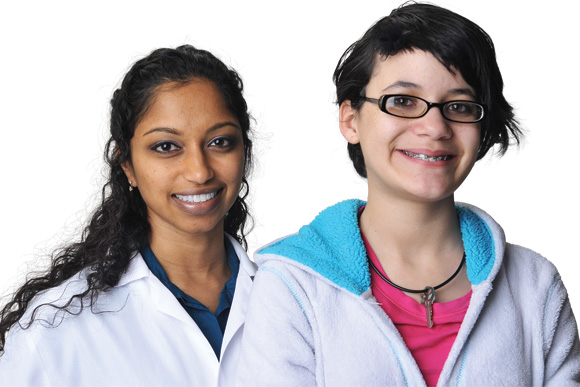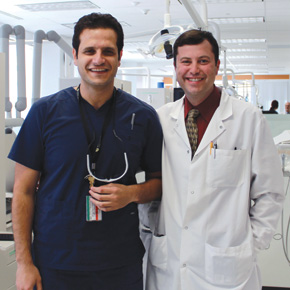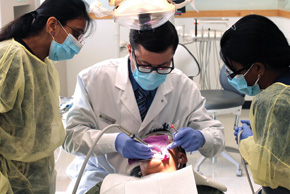
Dr. Avanthi Kapuri and her orthodontic patient
Faculty and students at the University of Colorado School of Dental Medicine work to educate families on the importance of oral health and provide many patients with a “dental home” -- a place where they can go to seek dental care and get routine check-ups and cleanings.
The school’s CU Dental Team Care student clinic sees adult patients for thorough comprehensive care, small children are referred to Healthy Smiles, the pediatric dental clinic at Children’s Hospital Colorado, and until last summer the adolescent age group was left struggling to find a permanent dental home.
While some pediatric dentists will refer adolescents to a general dentist because the patients have permanent teeth, general dentists may in turn prefer an adolescent patient be seen by a pediatric dentist because of the presence of primary teeth and continued development of the mouth.
“That age group is sort of wedged between pediatric dentistry and adult dentistry so they kind of get stuck with not a lot of good care,” says Elizabeth Shick, DDS, MPH, pediatric dentist and assistant professor.
Addressing the need
In August 2013, the school began to restructure the concept of child and adolescent care to address an unmet need in the patient community. As a result, the school created the CU Adolescent Dental Clinic to provide unique support and targeted care to this special patient population.
 "The value in having the dental students see adolescent patients is that they gain a variety of experiences they would otherwise miss during their dental training," says Rick Mediavilla, DDS, director of the clinic. "The students get to restore the mixed dentition, they treat patients during all the phases of orthodontic intervention, and they are often part of the initial diagnosis of many diseases that are discovered during the early teen years.
"The value in having the dental students see adolescent patients is that they gain a variety of experiences they would otherwise miss during their dental training," says Rick Mediavilla, DDS, director of the clinic. "The students get to restore the mixed dentition, they treat patients during all the phases of orthodontic intervention, and they are often part of the initial diagnosis of many diseases that are discovered during the early teen years.
“With the older teens, students realize that even though their patient's mouth may look like the adult ones they are used to treating, they require special considerations,” says Mediavilla. Addressing those considerations provides patients with a quality of specialty care and affords students career-building educational experiences.
Expanding the student experience
For several years students have completed a pediatric rotation at the Children’s Hospital Colorado Healthy Smiles Clinic while seeing their adult patients in the school’s CU Dental Team Care student clinics. By opening the adolescent clinic, students now experience and gain comfort caring for a wider range of patients, including those 12-18 years of age.
“What I love about the adolescent clinic is that it cares for an age population that is underserved,” says dental student Tamer Barsom. “We serve either the adult patients in the adult clinic or the pediatric patients at Children’s Hospital, so having this department here, serving the 12-18 age group, is different and lets us expand our connection with the society around us.”
Barsom is a second-year student in the International Student Program and is very involved in the clinic and intends to work with the adolescent age group in the future. He is currently applying to a General Practice Residency program in New York, after which he plans to open a private practice where he will treat adolescent patients.
“I got the best benefit out of [the clinic],” says Barsom. “I now enjoy treating this population. At this age, if you reach their trigger points on how they think and how you approach them, you will develop a good interaction with your patient.”
The adolescent clinic allows the school’s fourth-year dental students and second-year international dental students, such as Barsom, to provide prophylaxis, restorations, and some extractions for the patients.
“It’s cool having the age group 12-18,” says Barsom. “We learn what they do different dentally, and learn that some of them really don’t care about their dental health. They need more education on how to floss and how to brush, and catching them at the right time is good.”
Teenage trends
 Many of the children and teens visiting the clinic have not received dental care and have significant unmet dental needs. The adolescent clinic patients have high caries rates and decay patterns associated with consumption of sugar-sweetened beverages and drug use.
Many of the children and teens visiting the clinic have not received dental care and have significant unmet dental needs. The adolescent clinic patients have high caries rates and decay patterns associated with consumption of sugar-sweetened beverages and drug use.
Pregnancy gingivitis is also a concern and is reported among pregnant teens seen in the clinic. The Children’s Hospital Colorado has two different clinics-- the Colorado Adolescent Maternity Program (CAMP) and Young Mother’s Clinic (YMC)-- in their outpatient facilities, which collaborate with the adolescent clinic to treat and care for pregnant teens and teen mothers. These clinics provide comprehensive medical care and OBGYN care to these teens. Along with Shick, the dental students can now provide oral health screenings, education, and referrals to teen moms, their children, and their families at the time of their clinic visit.
Students have also seen cleft palate and cleft lip patients who are still in the middle of surgery and reconstruction, and recorded a visit with an ectodermal dysplasias patient. Patients going through orthodontic treatments may also be seen in the clinic for preventive care and restorations.
Clinical collaborations
The dental school thrives on collaboration, and with the adolescent clinic in place, patients are easily referred to other specialty clinics within the school. Patients complaining of severe pain or exhibiting signs of infection are easily referred to the endodontic clinic. The ease of referral allows the provider to begin early planning for implants based on the development of the patient’s mouth. Adolescence is also a common age for third-molar extractions and clinic patients may be referred to the General Practice Residency or oral surgery clinics for sedation and extraction.
The school’s orthodontic clinic works the closest with the adolescent clinic, which is conveniently located on the same floor, often sharing patients. “There isn’t much we can do orthodontically until we know that their mouth is healthy and everything is at a good state before we begin,” says orthodontic Associate Professor Nathan Moeller, DDS. “If they don’t have a primary care dentist, we will send them over and at least get them under the care of somebody who can follow them and get them back into the system.”
Once a patient is in braces or other orthodontic treatment, students in the adolescent clinic provide regular cleanings and fillings when the patient is without a primary dental provider. The students also provide oral health education on how to brush and floss in between brackets and other orthodontic appliances.
“It’s nice for patients to have everything under the same roof. Turnaround time is usually faster. It’s a big advantage,” says Moller. “It also helps the residents get used to collaborating and helps build their communication with other colleagues before entering into private practice.”
These collaborative experiences provide CU dental students a professional advantage whether they decide to enter a private practice or continue with a residency program. The students leave the school and their clinical education prepared to work with a wide range of patient ages and dental health needs and the skills to comfortably work and communicate with colleagues when referrals are needed.
Contact: Amanda.Gonzales@ucdenver.edu
